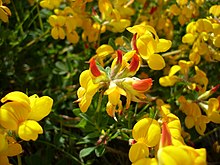Lotus corniculatus
| Lotus corniculatus | |
|---|---|

| |
| Scientific classification | |
| Kingdom: | |
| (unranked): | |
| (unranked): | |
| (unranked): | |
| Order: | |
| Family: | |
| Subfamily: | |
| Tribe: | |
| Genus: | |
| Species: | L. corniculatus
|
| Binomial name | |
| Lotus corniculatus | |
| Synonyms[1] | |
|
List
| |
Lotus corniculatus is a common flowering plant native to grassland in temperate Eurasia and North Africa. The common name is Bird's-foot Trefoil, though the common name is often also applied to other members of the genus. It is also known in cultivation in North America as Birdfoot Deervetch.
It is a perennial herbaceous plant, similar in appearance to some clovers. The flowers develop into small pea-like pods or legumes. The name 'bird's foot' refers to the appearance of the seed pods on their stalk. There are five leaflets, but with the central three held conspicuously above the others, hence the use of the name trefoil. It is often used as forage and is widely used as food for livestock due to its non-bloating properties.
The height of the plant is variable, from 5–20 cm, occasionally more where supported by other plants; the stems can reach up to 50 cm long. It is typically sprawling at the height of the surrounding grassland. It can survive fairly close grazing, trampling and mowing. It is most often found in sandy soils. It Flowers from June until September.
The plant has had many common English names in Britain, which are now mostly out of use. These names were often connected with the yellow and orange colour of the flowers, e.g. 'butter and eggs'. One name that is still used is Eggs and Bacon (or Bacon and eggs).[2]
Uses
It is used in agriculture as a forage plant, grown for pasture, hay, and silage. Taller growing cultivars have been developed for this. It may be used as an alternative to alfalfa in poor soils. It has become an invasive species in some regions of North America and Australia.
A double flowered variety is grown as an ornamental plant. The plant is an important nectar source for many insects and is also used as a larval food plant by many species of Lepidoptera such as Six-spot Burnet. It is regularly included as a component of wildflower mixes in Europe.
Fresh birdsfoot trefoil contains cyanogenic glycosides,[3] which releases small amounts of hydrogen cyanide when macerated. This is however not normally poisonous to humans, as the dose is very low, and the metabolization of cyanide is relatively quick.[4] Condensed Tannins are also present in Lotus Corniculatus, which has been known to increase the protein absorption of the small intestine.[5] Used in an infusion to avoid the creation of hydrogen cyanide this plant can be used as a sedative [6]
The plant is one of the few flowers in the language of flowers that has a negative connotation, symbolizing revenge or retribution.[citation needed]
References
- ^ "The Plant List: A Working List of All Plant Species". Retrieved March 14, 2014.
- ^ Collins English Dictionary
- ^ http://www.pfaf.org/database/plants.php?Lotus+corniculatus
- ^ http://www.jstor.org/discover/10.2307/4215630?uid=3737864&uid=2129&uid=2&uid=70&uid=4&sid=21101172845271
- ^ http://www.grassland.org.nz/publications/nzgrassland_publication_492.pdf
- ^ http://plantes-davenir.loncletom.fr/plants/lotus-corniculatus
